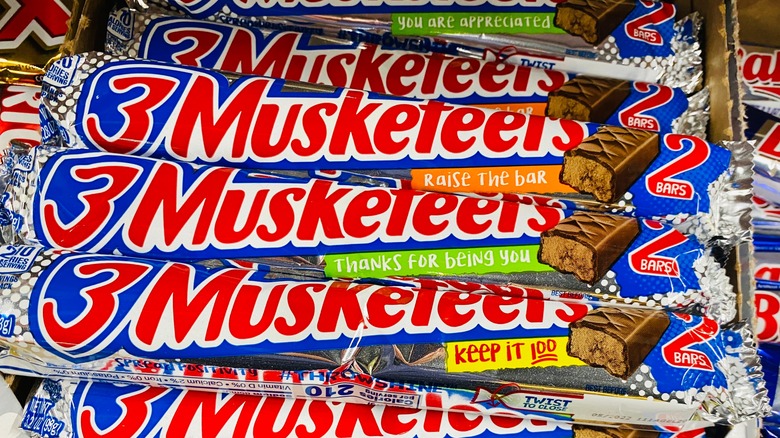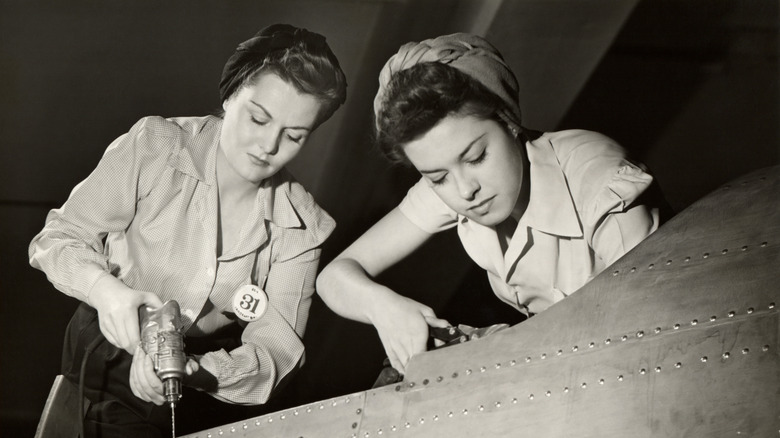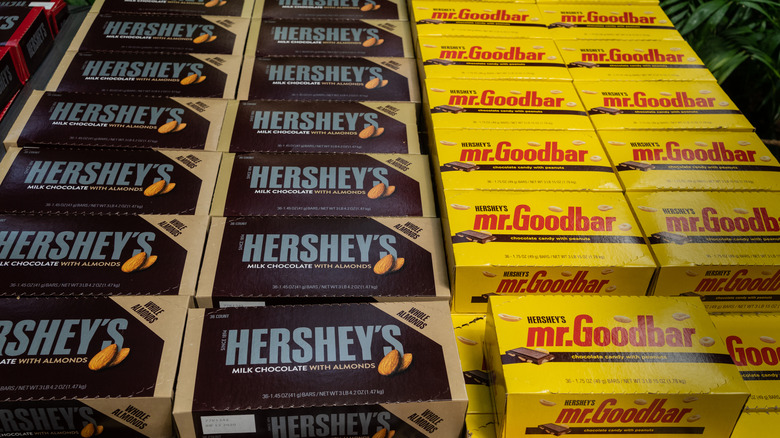How Food Rationing Helped Create The 3 Musketeers Bar We Know Today
Despite being one of the most simple candy bars in existence, 3 Musketeers is still one of America's most iconic candy brands today. In contrast to Snickers, Twix, and even Milky Way, 3 Musketeers consists of just two main elements: chocolate and whipped nougat. The only highly popular candy with a similar level of ingredient simplicity is Reese's, and yet, 3 Musketeers remains popular to this day.
But what you might not know is that 3 Musketeers bars originally looked very different from the version we know now. The product's name itself comes from the fact that it was originally sold in three flavors: A Neapolitan mix of chocolate, strawberry, and vanilla were in each package. The obvious potential connection to the 1844 novel The Three Musketeers by Alexandre Dumas pretty much wrote itself. But though the name stuck, its flavor variety was eventually limited to just the chocolate flavor you're familiar with today. So what happened? You can thank World War II.
Wartime rationing changed the game when it came to candy
Perhaps unsurprisingly for one of the biggest global conflicts in history, World War II had all sorts of downstream effects with minor, yet noticeable influences on modern life. One of these was the seismic shakeup it had on the confection industry.
By 1942, with the war in full swing, the U.S. government had begun rationing all sorts of staple products due to the war effort's constant and insatiable hunger for things like gas, rubber, and clothes. But nowhere was this rationing more prominent than when it came to food, where the list of rationed products included things like bacon, butter, eggs, sliced bread, milk...and even sugar.
It was this last item that got hit the hardest (particularly since chocolate was also eventually subject to rationing) and took the longest to recover; though the war ended in 1945, sugar rationing didn't cease until 1947 (it was even longer in the U.K., lasting until 1953). Unlike some other products, 3 Musketeers stayed on shelves throughout the war. But since sugar was hard to come by, the brand had to cut costs — and the main way they did this was by cutting out those strawberry and vanilla flavors. Thus, the modern 3 Musketeers bar became a singular heavily-armed French noble.
Some candy companies came up with clever solutions to food rationing
Nougat was (and is) a popular candy filling in large part because it's such a classic. A mixture of sugar or honey and whipped egg whites, and often accompanied by chopped roasted nuts or candied fruit, nougat recipes date all the way back to 10th century Baghdad, so clearly it's well-established. It makes sense that it was one of the first chocolate bar fillings because most people were already familiar with it.
3 Musketeers also isn't the only candy bar with a close connection to food rationing. Most companies were hit to some degree or another, but a few got it the worst: Jelly Babies (originally known as "Peace Babies") were discontinued entirely during the war, only re-emerging in 1953 with their new name.
By far the company with the most clever solution to wartime rationing was Mars's biggest competitor: Hershey's. Though it was the biggest name in candy, Hershey's had been hit hard by the Great Depression. In an effort to combat this, the company started pitching Mr. Goodbar as a cheap, energy-boosting food source. This branding ultimately proved a huge benefit to the company when the war hit, as Hershey's was easily able to pitch their products to the U.S. military as a portable, shelf-stable emergency food source for soldiers, collaborating with the government to manufacture chocolate bars to be included in military rations. People at home may not have had as much access to Hershey's bars, but thanks to Uncle Sam, the company itself was doing just fine.


